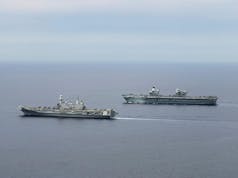The Defence and Security Accelerator (DASA) has announced the first wave of £4 million funding for warship artificial intelligence say the MoD.
“The funding aims to revolutionise the way warships make decisions and process thousands of strands of intelligence and data by using Artificial Intelligence (A.I.).”
Nine projects will share an initial £1 million to develop technology and innovative solutions to overcome increasing ‘information overload’ faced by crews as part of DASA’s ‘Intelligent Ship – The Next Generation competition’.
Defence Minister James Heappey said:
“The astonishing pace at which global threats are evolving requires new approaches and fresh-thinking to the way we develop our ideas and technology. The funding will research pioneering projects into how A.I and automation can support our armed forces in their essential day-to-day work.”
‘Intelligent Ship’ is focused on inventive approaches for Human-AI and AI-AI teaming for defence platforms – such as warships, aircraft, and land vehicles – in 2040 and beyond.
According to a news release, DASA, on behalf of the Defence Science and Technology Laboratory (Dstl), is looking at how future defence platforms can be designed and optimised to exploit current and future advances in:
- Automation
- Autonomy
- Machine learning
- Artificial Intelligence
This work will inform requirements then develop applications essential to the future force in an increasingly complex and A.I. driven environment. Although titled Intelligent Ship, a warship is just the prototype demonstrator for this competition – the project will inform development relevant to all defence equipment and military services.
Julia Tagg, technical lead from Dstl, said:
“This DASA competition has the potential to lead the transformation of our defence platforms, leading to a sea change in the relationships between AI and human teams. This will ensure UK defence remains an effective, capable force for good in a rapidly changing technological landscape. Crews are already facing information overload with thousands of sources of data, intelligence, and information. By harnessing automation, autonomy, machine learning and artificial intelligence with the real-life skill and experience of our men and women, we can revolutionise the way future fleets are put together and operate to keep the UK safe.”
The competition, currently backed by a total of £4 million over two phases, has the potential to transform the way the Royal Navy, British Army and Royal Air Force equipment platforms are designed, work together, operated and manned by the 2040s. Innovations developed in phase 1 of the competition could later help determine the different platform types, size and role of future platforms as well potentially being adapted and integrated into the existing fleet.














I keep thinking that if the RN could get some money out of the treasury to build two new Amphibious ships to replace Albion and Bulwark the current ships would make good convertion platforms for AI, automation, autonomy and mother ship development. There would be enough space for computers, scientists, engineers and remote operating stations and an internal dock for all the secret stuff that would be tested and operated. There would also be enough space for a hanger to test UAVs. We could even hire the ships out to our allies for their testing.
Depending on when the Albions became available might they not have too high a resale value to want to give up? (We did manage to sell off Ocean after all and she was far less solidly built and very much worn out.)
I would have thought that a Bay Class, once retired, would give similar big internal space for hosting teams plus flight deck, space for a hangar already demonstrated and sometimes installed, and an internal dock although admittedly a much smaller one than in the Albions.
The Bays are only built to commercial standards which wouldn’t be of any interest for a test ship since it would never go into combat whereas the Albions’ military construction standards should boost resale value if sold but be an unexploited attribute if retained as a test ship.
Notwithstanding my nit-pick above I like the overall concept of nominating a capable and spacious test bed vessel and potentially hiring it out to allies for their testing. It would be a serious statement of intent on our part.
True, many of your points are valid, it was just that I was thinking about the dock capability. However your points about the Bays are good one and these when replaced could possibly be used or sold (if there is still a good life span in them) to the Department for International Aid and used for humanitarian and medical ships under the flag (which could be the Red Cross flag with a Union Jack in the first quater) of International Aid. This would put a demarcation line between soft power and hard power in both finance and assets. It would just depend on how the future UK would see and look at itself in the world.
Giving out false signals and positioning is threatening and being able to recognise such data too would be game changing.
Programming should be a national urgency and should be part of schools going forward.